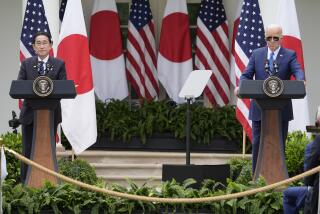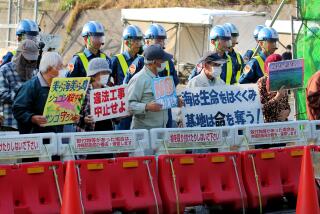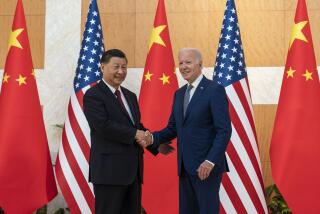PACIFIC PERSPECTIVE : Trade Hawks Threaten the Peace : The Administration appears ready to risk war so that Toys R Us can sell Barbie dolls to Tokyo suburbanites.
- Share via
OXFORD — The Bush Administration’s policy toward Japan and Asia has been a failure. No doubt those who have briefed the President in advance of his trip to Australia, Singapore, South Korea and Japan will have argued otherwise. On Tuesday when Bush arrives in Tokyo for his first visit since taking office, Japanese officials also will put on agreeable faces to ensure that he has a pleasant stay. But the policy indictment stands.
Three years after the Bush Administration abandoned the principles that have guided American policy toward Japan since 1945, one would like to think that the President has come calling at a critical time in U.S.-Japan relations. This is not the case. The damage has been done.
Urged on by flatulent trade hawks, the Bush Administration has injected a new poisonous rancor into our relations with Japan. Three years of Japan-bashing folly has evaporated the pool of mutual goodwill so carefully nurtured since the war. Pro-American feeling in Japan has plummeted.
And to what end? Our trade imbalance with Japan still stands at $40 billion, just as it did at the end of Bush’s first year in office.
But pinched Japanese feelings are not the main question. Quite the contrary, these purveyors of foreign-policy snake medicine--be they anti-Japanese revisionist cranks or twitchy Democrats hungry for electoral advantage--are undermining American interests in Asia.
It is therefore time to survey the wreckage, assess the causes and ask how Bush or his successor might put things right.
Although sometimes overshadowed by our fetish with Asian communism and the more real threat posed by Soviet naval ambitions, the cardinal goal of U.S. foreign policy in the Pacific from Truman to Reagan was clear and steady: There must be no repeat of war with Japan.
This was the lesson of the gruesome American blood bath at the World War II battles of Tarawa and Okinawa. It is why we have put up with Japanese commercial “hardball” (as we have with German mercantilism) for more than four decades.
Looking back now it is clear that Mike Mansfield was right. Throughout his 12 years as American ambassador to Japan for Carter and Reagan, he insisted that our tie with Japan was our most important bilateral relationship, and that it therefore had to be treated as such.
After Mansfield came home, Bush handed over our Asian policy to a few ambitious Commerce and State Department officials who hold the opposite view: that WWII never happened and therefore U.S.-Japan relations could be subjected to any level of abuse and bombast.
It is one thing to argue that Japanese protectionism is provocative (which it is) and quite another to say that Japanese clumsiness (remember their fatuous banning of U.S.-made baseball bats) and hubris should encourage America to neglect its own strategic interests in the Pacific.
It now appears that the Bush Administration is prepared to risk another Tarawa so that Toys R Us can sell Barbie dolls to Tokyo suburbanites. It has yet to learn how to balance our defense and trade interests in the Asia-Pacific rim.
New Asian realities must be taken to heart. With the collapse of the Soviet Union, Japan has the world’s second largest defense budget. It already has more destroyers in the Pacific than we do. Furthermore, the glue that has held the U.S.-Japan security pact together--the Soviet threat--is dissolving.
If this were not enough, East Asia remains a tangle of disputed boundaries and dangerous national hatreds. The eventual collapse of communist North Korea may make the Romanian revolution look like a garden party. There is the enormous question mark hanging over China. The Asian Century could be a century of war.
Today, for a mere $30 billion in defense costs, the United States keeps the Western Pacific what it has been since 1945: an American lake--Japan and South Korea already pick up a large part of the tab for maintaining the Pax Americana in a region stretching from San Diego to Singapore. Existing collective security arrangements need to be strengthened, not undermined. East Asian economic integration (which the Administration opposes) should also be encouraged.
The point is crucial. If we play our cards right, if Washington can learn to distinguish the baby from the bath water (that is, our legitimate defense interests from trade policy complacency), we might just manage to ensure that no American son or daughter has to die to keep the peace in the Pacific for a generation.
This goal would still be worth striving for if our trade deficit with Japan was $100 billion. What trade hawk would dare to put a price on a young American life? And this perception houses the most central truth of all: What most Americans seek in our relationship with the outside world is control of our destiny as a nation, some sense that we are masters of our fate.
Nothing would so cheer American public opinion as news that Detroit had begun to win back a major part of the domestic market share that it has conceded so easily to Japanese auto makers. And nothing would do more to bolster Japanese respect for us.
Hence the supreme irony that Bush arrives in Tokyo with leaders of America’s Big Three car manufacturers in tow. The Japanese find this a fantastic gesture. No Japanese executive would dream of globe-trotting if his firm were in similar trouble at home.
A full three-quarters of America’s deficit with Japan is auto-related. The playing field may be tilted against us abroad, but not at home. If GM cannot sell Chevrolets in Long Beach, it will never sell them in Osaka.
The rancorous policies of the past three years have achieved nothing. The Japanese are not going to change. It is time for an Asian policy grounded in home truths. Bush could do worse than to seek peace abroad and competitiveness at home.
More to Read
Get the L.A. Times Politics newsletter
Deeply reported insights into legislation, politics and policy from Sacramento, Washington and beyond. In your inbox three times per week.
You may occasionally receive promotional content from the Los Angeles Times.










